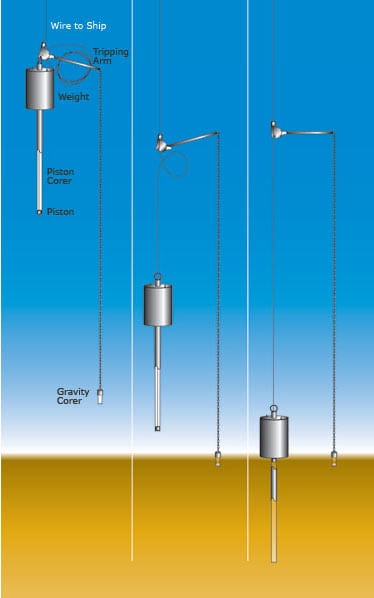Piston Corer
What is it and why do we use it?
The piston corer is a long, heavy tube plunged into the seafloor to extract samples of mud sediment. A piston inside the tube allows scientists to capture the longest possible samples, up to 90 feet in length. They are simple and elegant in design; in 1947, scientist Maurice Ewing said that a piston corer "brings up samples of the ocean floor just as a housewife cores an apple."
How is the piston corer different from other corers?
The goal of all corers is to extract samples of mud. Ewing once referred to corers as cookie cutters. The length and diameter of the mud cookies they extract depends on the type of corer used. Traditional corers are quite simple in design: a long tube surmounted by a ton or so of lead. In the late 1940s, the Swedish oceanographer Borje Kullenberg made modifications on this design, adding an internal piston that helps researchers gather even longer mud samples. Piston corers, like their cousin the gravity corer, are generally used in areas with soft sediment, such as clay. A gravity corer is just a weighted pipe that is allowed to free fall into the water. Piston corers have a piston mechanism that is triggered when the corer hits the bottom. The piston helps to avoid disturbing the sediment.
What enables a corer to capture a sediment sample?
If you have ever poked a straw into a milkshake, put your finger over the top of the straw, then extracted the straw with the ice cream trapped inside, you have an idea of how the piston corer works. Like the straw, the corer plunges into the seafloor and collects mud in its hollow open pipe. A seal on the bottom of the device will retain the sediment sample during retrieval.
What are the advantages of using a piston corer?
Simply making a gravity corer longer does not insure the recovery of a longer sample. The addition of the internal piston allows the soft sediment to be captured without significant compression or disturbance. This allows researchers to capture the best possible sediment sample.
What are the disadvantages of using a piston corer?
They are heavy, long, and sometimes difficult to handle. Because of the operations involved and equipment needed, piston corers cannot be executed from every research vessel. Special handling equipment is required to safely launch and recover a deep sea piston coring system.
Why are cores from the ocean special?
Cores extracted from the sea are especially useful because, unlike land sediments, they are largely undisturbed; no people have dug around them, or walked on top of them. By minimizing disturbance, scientists are able to see the clearest picture of specific time periods on Earth.
Why study sediment?
By studying sediment, scientists can learn about ocean circulation, climate, the formation of ore deposits, the movement of oceanic plates, salinity of water, and the stability of the seafloor for oil drilling and exploration. Sediment cores allow scientists to see the presence or absence of specific fossils that may indicate climate patterns at times in the past, such as during the ice ages. Some scientists refer to the cores as time capsules, because the information they contain can span the past hundreds of thousands and even millions of years. Scientists may then use this information to improve understanding of the climate system and predict patterns and events in the future.
Sources
Jim Broda, research specialist in the Geology and Geophysics Department at WHOI
Lamont-Doherty Earth Observatory of Columbia University: Twelve Perspectives on the First 50 Years, 1949-1999
Woods Hole Oceanographic Institution Exhibit Center, coring exhibit (text by Stephanie Murphy)
See Also
WHOI Media Release
Dec. 2003-New Piston Corer Will Give U.S. Scientists their Deepest Reach into Sea Floor
"Oceanography" at 13,000 feet
Currents article about coring Lake Titicaca in the Andes Mountains (pdf version)
James Broda
Read about a researcher who takes mud samples using piston corers

